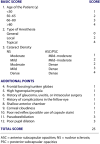Validation of Najjar-Awwad cataract surgery risk score for resident phacoemulsification surgery
- PMID: 20870123
- PMCID: PMC5595548
- DOI: 10.1016/j.jcrs.2010.04.035
Validation of Najjar-Awwad cataract surgery risk score for resident phacoemulsification surgery
Abstract
Purpose: To validate the Najjar-Awwad cataract surgery risk score for residents, which has been proposed to predict surgical complexity and risk.
Setting: Two urban public county hospitals.
Design: Case series.
Methods: Phacoemulsification cataract surgeries performed by residents between January 2005 and April 2008 were retrospectively reviewed. The cataract risk score was calculated retrospectively. Intraoperative complications included posterior and anterior capsular tears, vitreous prolapse, dropped nucleus, and conversion to manual extracapsular cataract extraction.
Results: Of the cases performed by 33 residents, 1833 met the inclusion criteria. There were 120 complications (6.5%); the rate of complications involving vitreous prolapse or loss (including dropped nucleus) was 3.2%. Significant risk factors in the risk score associated with intraoperative complications were dense nuclear sclerosis (odds ratio [OR], 2.08; 95% confidence interval [CI], 1.32-3.26; P = .004) and poor red reflex (OR, 2.10; 95% CI, 1.45-3.06; P = .00007). Cataract risk scores ranged from 3 to 16. The score was less than 5 in 85 cases (4.6%) and less than 7 in 885 cases (48.3%). The OR for complications increased significantly when the risk score was higher than 6 (OR, 2.11; 95% CI, 1.42-3.14; P = .0002).
Conclusions: Although the Najjar-Awwad cataract surgery risk score can be used to predict intraoperative complications at the time of cataract surgery, the complication rate did not significantly increase until the score reached 7. There were few cases with scores lower than 5 in these county hospital populations. Beginning surgeons should be given cases with a risk score of less than 7.
Copyright © 2010 ASCRS and ESCRS. Published by Elsevier Inc. All rights reserved.
Figures
References
-
- Tayanithi P, Pungpapong K, Siramput P. Vitreous loss during phacoemulsification learning curve performed by third-year residents. J Med Assoc Thai. 2005;88(suppl 9):S89–S93. - PubMed
-
- Johnston RL, Taylor H, Smith R, Sparrow JM. The Cataract National Dataset electronic multicentre audit of 55,567 operations: variation in posterior capsule rupture rates between surgeons. Eye. 2010;24:888–893. - PubMed
-
- Artzén D, Lundström M, Behndig A, Stenevi U, Lydahl E, Montan P. Capsule complication during cataract surgery: case-control study of preoperative and intraoperative risk factors; Swedish Capsule Rupture Study Group report 2. J Cataract Refract Surg. 2009;35:1688–1693. - PubMed
-
- Randleman JB, Wolfe JD, Woodward M, Lynn MJ, Cherwek DH, Srivastava SK. The resident surgeon phacoemulsification learning curve. Arch Ophthalmol. 2007;125:1215–1219. Available at: http://archopht.ama-assn.org/cgi/reprint/125/9/1215. Accessed June 8, 2010. - PubMed
-
- Rogers GM, Oetting TA, Lee AG, Grignon C, Greenlee E, Johnson AT, Beaver HA, Carter K. Impact of a structured surgical curriculum on ophthalmic resident cataract surgery rates. J Cataract Refract Surg. 2009;35:1956–1960. - PubMed
Publication types
MeSH terms
Grants and funding
LinkOut - more resources
Full Text Sources
Miscellaneous



